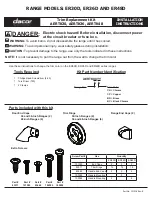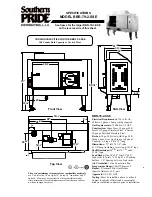
CERAMIC WORK-TOP
The work-top is fitted with cooking areas of different
diameter and power.
The positions are clearly marked. The heating occurs
only within the diameters marked on the work-top.
For
efficient cooking and energy saving, it's essential to
use only suitable saucepans.
Cookware with rough bottoms should not be used
since these can scratch the ceramic surface. Before
use, make sure that pan bottoms are clean and dry.
Pans should have the same diameter as the cooking
zone they are used on.
When cold, pan bottoms should be slightly concave,
as they expand when they are hot and lie flat on the
surface of the hob. This tansfers the heat best.
The best thickness for pan bottoms is 2-3mm in case
of enamelled steel and 4-6mm for stainless steel with
sandwich type bottoms.
There is a simple way of checking whether the pan
bottom is of the right shape (when cold).
Rest the middle of the bottom at an angle against the
straight edge of a table and slip a few strips of typing
paper between them.
As a guide five to ten pieces of paper is correct for
enamelled steel pans and two to five strips for
stainless steel (the higher number applies to the
larger sizes of pan).
These rules are very importatn. If they are not
followed there will be a great loss of heat and energy,
and the heat not absorbed by the saucepan will
spread to the hob, frame and surrounding cabinet.
Using the cooking hob
The first few times the hob is used, it may give off
acrid, burning smells.
These will disappear completely with repeated use.
Each cooking area has a selector knob on the
appliance control panel for setting different
temperature levels.
For normal cooking, place the saucepan on the
desired area of the hob and set the knob to the
maximum heat.
A warning light on the control panel will inform you if
the cooking area is on or off.
Some of the cooking work-tops have an indicator light
between the two front cook
ing areas, which lights up
when one or more of the cooking areas goes above
the temperature of 60
o
C
.
The indicator light switches off only when the
temperature of the cooking areas goes below about
60
o
C.
After a few minutes, when the contents of the
saucepan are boiling, turn the knob to a lower
position, depending on the quantity, so that the
saucepan does not splash over and there is no waste
of heat.
USING ELECTRIC HOTPLATES
When using an electric hotplate for the first time or
after a long period of disuse, turn the knob to 1 and let
it heat for about 20 minutes to eliminate any possible
moisture absorbed by the internal insulating material.
-Dry the bottom of the pan before placing it on the
hotplate.
-Turn the hotplate on only after placing the pan on it.
The hotplate is controlled by a commutator. Turn the
knob until position 1 to turn the hotplate on (Fig.1).
A warning light on the control panel will inform you if
the plate is on or off.
USE OF PLATES WITH TWIN-CIRCUIT
ENERGY REGULATOR
The plate is controlled by an energy regulator.
1) To activate the first circuit, rotate the knob from 1 to
11.
2) To activate the second circuit, rotate the knob past
the number 11 (Fig.2).
To return to single-circuit operation, reset the knob to
zero then to the number required.
GUIDELINE TABLE
The actual settings depend on the quantity and quality
of the food and the type of saucepan.
GLASS-CERAMIC SURFACE
To clean the work-top, you must follow the same
precautions you use to clean the glasses of your
house. Soft stains caused by aluminium pans bottoms
can be removed by means of vinegar.
Make sure that sugar does not fall on the work-top
during cooking, if it falls disconnect the relevant
hotplate, and clean as soon as possible with hot
water, before it gets cold.
In case there are stains of burnt sugar or similars after
cooking, clean them using a spatule or a razor before
the cooking zone becomes cold (see picture).
Important
Be very careful about the safety of children when
using the ceramic hob.
Attention
Although the hob surface is very tough, it is certainly
not unbreakable and it can be damaged, especially if
pointed or hard objects fall on it with a certain force.
Do not use the hob if the surface is broken or cracked;
contact the assistance service immediately.
Heat
Intensity
Use
0
0
Off
1 - 2
1
Very slow For melting butter, chocolate, etc.
For heating small amounts of liquid.
3 - 4
2
Low
For heating larger amounts of liquid.
For preparing slow-cooking creams and sauces.
5 - 6
3
Medium-
Low
For thawing frozen foods and cooking stews,
cooking at boiling or lower temperatures.
7 - 8
4
Medium For boiling foods, roasting delicate meats and fish.
9 - 10
5
High
For braising chops and steaks, for large meat
soups.
11
6
Very High For boiling large amounts of water and frying.
Pos.
INSTRUCTIONS FOR USE OF THE CERAMIC WORK-TOP
24
















































